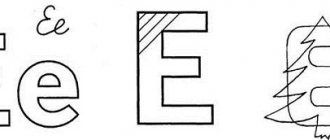Today, problems of spelling begin to be dealt with from an early age: in many kindergartens there are school preparation groups, in which children learn the basics of literacy - the concepts of letters, sounds, syllables, stress. And this is no coincidence, because this knowledge is necessary for a first grader. One of the common problems is unstressed and stressed vowel sounds. How to distinguish them? How to check for questionable vowels at the root?
How to distinguish impact sound?
It is often unclear to a 5-6 year old child on what principle we, adults, distinguish between stressed and unstressed sounds. And our explanations that a stressed syllable is strong, that stress is placed on it, emphasis during pronunciation, may not mean anything to him. How can I explain this more clearly?
There are simple ways:
- Ask the child to speak with his hand under his chin. Whichever sound the chin touches the hand with is stronger, the one is percussive.
- Explain that a stressed sound always sounds and is written the same, but an unstressed sound does not always.
- Suggest the word “call”. The stressed syllable will be the longest, and the word will not be distorted (kAAApusta or capUUUsta?).
At the same time, you should not confuse the concepts “you can stretch” and “the longest,” because you can stretch any vowel sound - that’s why it’s a vowel. But the stress always reveals precisely the length of the pronunciation.
And further. A preschooler or schoolchild should clearly know that there is always only one stressed syllable in any lexeme. And the emphasis falls on the pronounced sound, and not on the letter. A letter is simply a graphic representation of a phonetic unit.
There are various games to help master and reinforce the concept of stress. For example, you can pronounce syllables by directing your exhalation towards the flame of a candle. The child will clearly see from the vibrations of the flame how many syllables a word contains and which of them is stressed.
You can show your child the importance of correct stress placement by giving examples of homonyms that are written the same, but in oral speech are distinguishable only by the stressed syllable.
A preschooler can see that the strong position sometimes “floats” through parts of the lexeme by playing French (as is known, in the French language the stressed position is strictly assigned to the last syllable). That is, he needs to try to name different objects in this way.
If the baby does not see (or rather, does not hear) the difference between milk and milk (or perhaps simply has no idea how to pronounce it correctly), do not rush to “load” him with stressed syllables. Take up speech culture, train the correct pronunciation of words, and develop phonemic awareness. Provoke him as much as possible to name objects or actions whose emphasis he is confused about. Correct, show the right example. That is, develop in him the ability to speak and hear stress correctly. Only after this does it make sense to explain to him how to “call” the words.
Stressed vowel sounds
A stressed vowel sound is a vowel sound that is pronounced when pronounced by the voice. That is, the one on which the emphasis falls. This sound is always pronounced more clearly. Compared to the unstressed one, it is in a stronger position and plays a meaningful role. As a rule, writing letters that convey stressed vowels does not cause difficulties.
For example, in the words small (stress on the first syllable), peaceful (stress on the first syllable), distant (stress on the second syllable), the spelling of stressed syllables will not cause doubts in anyone. The principle “as it is heard is how it is written” applies here, and sounds are heard clearly.
Stressed vowel sounds are designed to perform the function of meaning differentiation. For comparison: mole, mal, soap, mule - words that we distinguish by ear due to the fact that different vowels are written in them.
Spelling - unstressed vowel sound at the root
Having learned to identify stress, a child can also master the basic spelling associated with it: the unstressed vowel at the root.
To make it easier for a child to understand what a spelling is, you can explain it to him this way: a spelling is the most “mistaken” sound of a word, the place where you can most often make the wrong spelling, because you have to choose the correct one from several options.
To select it, you need to check the spelling. An unstressed sound is fundamentally checked by stress (after all, it is under stress that the sound is pronounced and written in the same way). To do this, you need to choose a test word. This is a modified word being tested or another word of the same root, related and close in meaning, where the weak position changes to a strong, stressed one.
Accordingly, in order to use this rule correctly, the baby must be able to:
- distinguish between consonants and vowels;
- find vowels in strong and weak positions;
- transfer stress from one part of the lexeme to another;
- determine in which part of it the weak sound is located;
- change the form of a word, select several cognates for it, choose from all these options the one that can act as a test.
Difficulties are caused by the fact that, unfortunately, this spelling does not provide a ready-made algorithm with a graphic example of the correct spelling, but implies its independent selection. To do this, the child must know and understand what, with what and how to check in each specific case.
Vowels and sounds - how they differ
“It’s not difficult to count them
Remember: there are six sounds.”
There are 10 vowel letters in the Russian alphabet: a, e, ё, i, o, u, y, e, yu, ya. What about vowel sounds?
In the Russian language there are only 6 vowel sounds - [a], [o], [u], [e], [i], [s], but they play a very important role in the formation of syllables - it is thanks to them that the speech flow can be divided into phrases-words-syllables. A syllable is the smallest phonetic unit, it is characterized by the unity of the sounds included in it: a combination of sounds pronounced in one exhalation of air: [ma] - [ma].
Important: Vowel sounds form syllables, and they can do this even without the participation of consonants; consonants cannot form syllables without vowels.
Why are there 10 letters, but only 6 sounds? The letters e, e, yu, i in writing indicate a combination of sounds: a soft consonant [th] and a vowel sound. As a result, all vowel letters and sounds can be presented in the form of a table:
Table “Vowel sounds and letters in the Russian language”
| Letters | A | E | Yo | AND | ABOUT | U | Y | E | YU | I |
| Vowel sounds | A | E | ABOUT | AND | ABOUT | U | Y | E | U | A |
| Consonants | Y | Y | Y | Y |
The table shows which letters represent vowel sounds and which represent combinations of sounds.
Vowel letters I, E, E, Yu, I
Why such difficulties? And why does a vowel sound need such a friend - the consonant sound [th]?
The vowels a, o, u, e, s indicate the hardness of the previous consonant sound: [house], [smoke], [dacha], [cat], [fish]. Everything is simple here - the letter and the sound correspond to each other.
The vowels e, e, yu, i are needed to indicate in writing the softness of the previous consonant: river, honey, love, ball. Without softening the consonants r, m, l, the words would be pronounced like this: [reka], [mot], [lubof], [mach].
Vowel sounds allow them to become softer: river - [r' e k a]; honey - [m' o t]; love - [l' y b o f']; ball - [m' a h'].
Important: in the middle of the word, the vowels e, e, yu, i indicate the softness of the previous consonant.
If these letters end up at the beginning of a word, they immediately have a “friend” - the soft consonant th. In these cases, the letters e, e, yu, i form a pair with it
raccoon - [y'e n o t],
Christmas tree - [y' o l k a],
yula - [y' u la],
apple - [y' a b l o k o].
The same thing happens in the middle of a word after a vowel, ь or ъ
ate - [s y' e l],
drink - [p y' o sh'],
blizzard - [in y' u g a],
mine is [m a y'a].
Important: the vowel letters e, ё, yu, i are not sounds.
The letter stands apart and - its purpose is to indicate the softness of the previous consonant sound: [k'iska], [m'iska], [l'isa]. In the stressed position, the letter and corresponds to the sound [and]. However, in conversation, the sound [i] is also heard in the following words: - whatnot; - watch; - hippopotamus.
That is, in unstressed syllables the letters are different: e, a, e, but the sound is the same - [i].
Memo "Vowel sounds and letters"
Video “Vowels and sounds”
What difficulties may arise?
And this is where the main difficulties begin. The reasons for frequent errors are different, but the main ones are the following:
- the child cannot find a word in the text that contains an unstressed phoneme;
- cannot isolate a root to find an orthogram in it;
- he is unable to change the word so that the sound becomes in a stressed position;
- The baby has a meager vocabulary that does not contain words suitable for testing.
In order to cope with all this, in addition to the mandatory expansion of vocabulary, it is necessary to perform exercises that solve various problems: they teach you to find words that correspond to a given spelling, use the rule itself, and use it freely when writing any text.
If your child doesn’t know yet, draw his attention to the fact that the letter E always means a stressed sound. This will help him never make mistakes in words that contain it.
Unchecked vowels in roots
The most difficult case from a spelling point of view is unstressed vowel sounds in untestable words. When it is impossible to choose an option with an impact root.
The correct options in such situations can only be remembered or always carry a dictionary with you in which you can look up the spelling.
Words that fall under this section include, for example: meridian, vinaigrette, concrete, corvalol, cheesecake and others. Many of them are of foreign origin.
Types of exercises
What exercises can help in this situation? The more varied they are, the better. They can be aimed at different aspects of the development of understanding of spelling:
- Finding words that fall under a given spelling (searching for unstressed and stressed phonemes in different parts of a word, comparing graphic images and spelling of phonemes in weak and strong positions in the root of a word, searching for spellings among words with the same root, in sentences, various texts).
- The practical application of the rule is to develop the ability to find test words based on the necessary characteristics (comparing words with stressed and unstressed positions of the phoneme in the root, choosing test words from a certain number of the same root, from various word forms, choosing a test word denoting the object itself, its sign, action; distinguishing test words that are a modified form of a word and a word with the same root, selecting several test words).
- General development of speech with an emphasis on the topic of stress (studying cognates, developing the skill of selecting the desired meaning of a word in the process of selecting a number of cognates for it, studying polysemantic words, direct and figurative meanings, antonyms, synonyms, training in composing phrases, sentences, completing tasks when cheating or dictation).
If parents are unable to choose the right texts for such exercises or organize classes, or the child is unclear or uninterested, educational cartoons can come to the rescue. Fortunately, today you can find a lot of high-quality pedagogical cartoons on the Internet. In an accessible and fun way, your child can find answers to all questions on the topic of stress. At the same time, the information will be absorbed much easier, since it is presented not in the form of a boring lesson, but in the form of a game with the participation of cheerful, inquisitive characters.
Unfortunately, human speech does not fit into the framework of exact science. This is a living, moving system, in which a lot happens according to the laws of harmony, sense of style, even intuition. These are not exact formulas, as, for example, in mathematics. This is probably why children most often have problems when learning language, and not calculations. This means that classes on the comprehensive development of children’s speech are one of the primary tasks of every parent who claims to be a loving and caring parent.



